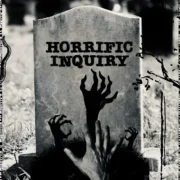What Is Mise-en-Scène? Pt I: Setting & Costume
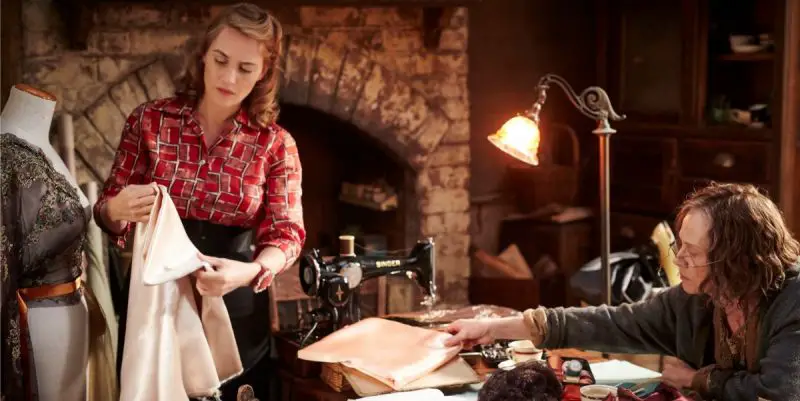
I love film, more than people probably, and I will…
Mise-en-scène is one of the great terms used in film criticism. It is also the most basic and is usually the first thing you’ll learn on any film theory course. Unfortunately mise-en-scène is also, strangely, one of the hardest terms to understand. Literally translated, the term means to ‘put on stage’ or ‘put in the scene’ (although I asked a French friend once and she described it as ‘organising furniture in a tableau’). The best way to understand the term it is to first think of a moment in a film you really love. Now, conjure up a freeze frame of this moment. Think of how it looks: how the actor is placed, what they were wearing, how the shot is lit. That there, that is the mise-en-scène.
Mise-en-scène can be broken down into a couple of elements. An analysis generally looks at the space, drawing in on the actor, then looking forward to what comes after that frame. So, firstly we look at the setting, costume & make-up, objects (props), then cinematography (which includes camera angle, and most importantly, lighting). Then we look at the actor, what are they doing in the scene?
Finally, we look at the fourth dimension: time, and analyse how movement and editing is used. In each of these elements the act of observation is paired with the analysis of symbolism (or semiotics), understanding not only what each element means objectively but what its meaning might be.
Setting
When it comes to setting, as with many aspects of mise-en-scène, often the meaning is not much more than you imagine. In most generic romantic comedies or action movies the settings are created or presented to be easily recognisable to the audience. They’re fit for purpose, they don’t really mean anything. Although in the case of some auteur directors their particular vision for the story can shine through in something as mundane as the décor.
The director Nancy Meyers has become known for the ‘show home’ look she used in films such as Something’s Gotta Give and The Holiday, where the fantasy element of the romance extends down to the perfect furnishings and lighting. Perhaps more popularly recognised is the Gothic imagery frequently used by Tim Burton, whose work dwells on tall towers and stark landscapes, reminiscent of familiar horror tales. At the end other end of the scale we have directors such as David Lynch, whose use of setting swings between a physical representation of the character’s mind and an almost a nihilistic approach to filmmaking. Where all meaning or reason is disregarded.
Setting can sometimes be the epicentre of a film’s narrative. Take the film Buried. The entire of the film’s narrative takes place in a box not much bigger than a coffin, where Ryan Reynolds’ Paul Conroy is being held for ransom. The darkness of the box is lit only by a mobile phone and a cigarette lighter. This is one of the more obvious cases where the mise-en-scène has been used to enhance the audience’s connection with the character. The intensity of the blackness and the claustrophobia of the surroundings seek to put us off balance and draw us into Paul’s desperation. It was a risk for the filmmakers, but one which works admirably well.
However, the consideration of setting when discussing mise-en-scène is usually more abstract. With, in particular, the outside world reflecting the tone of the film, or the journey of the characters. In the Western the landscape is paid particular attention to. Many Westerns usually feature a quest to find or defend something or someone dear to the film’s protagonist. So the director frequently draws the audience’s attention to the wide empty landscape to emphasise the loneliness of the bounty hunter or the hopelessness of finding a loved one. John Ford did this to tremendous effect in The Searchers.
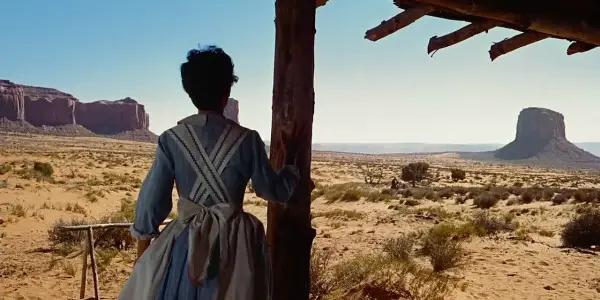
The outdoors has been used time and time again to emphasise a character’s sense of loss, but also longing. As in the case of Bernardo Bertolucci’s Stealing Beauty, where virginal Lucy’s desire to be seen as a woman is reflected in the beauty of the Tuscan setting. For the most part, setting in mise-en-scène is easily recognised and understood for what the director is intimating. Because these physical properties, along with the narrative, influence how the actors move, how the camera is placed, etc. So, feelings of hope, sadness, elation and so on are usually self-evident. But there is no denying the influence of a well-chosen setting and how it is shot.
Costume & Make-Up
One of the most useful tools in communicating a character’s thoughts and journey throughout a narrative is costume and make-up. Perhaps because, unlike the filming locations being used, the actor can change clothes on a whim or endure hours of prosthetic make-up work. What the character is wearing and how it is arranged can say a lot about them, or not much at all. Which is equally important.
In the film convention, one that he is hanging on to, a rule of logic and clinical withdrawal that keeps him apart from the madness around him. It also alienates him, keeping him from the audience, representing him as just another man in a suit.
Costume can also be used as a more deliberate tool in narrative, which makes it a highly functioning part of the mise-en-scene. For example, in The Village the yellow cloaks act as a deterent to the beast stalking the villagers. The garish yellow stands out strongly against the wooded background, its daring brightness almost a challenge to the creature. A daring choice that confuses the audience as to whether the villagers are that stupid or perhaps, that smart. When Ivy makes her way through the forest her confrontation with the beast covers her in mud. Her blindness means she is aware of this fact but can do nothing to fix it. The absence of colour stands on in stark contrast to the red robe of the beast that attacks her. Here, colour and costume is used to invoke tension and fear.
Red cloaks, dresses and coats are particularly divisive in film. Red can represent fear, sexuality, blood and death, even hope and joy. More than once it has been used in a combination of all these elements. In Jezebel, the protagonist Julie goes to a black and white ball in a daring red dress. Her clear drive for attention (and seeming sexual arrogance) is displayed with abandon as she is shown in stark comparison to her peer group, the frame centering on her affront to the monochrome costumes of the extras. Or, at least, that is how it should have been seen, but Jezebel is a black and white film so much of the impact was lost.
The red coat has been used time and again in cinema. In the opening scenes of Don’t Look Now it simultaneously draws attention to Christine’s childlike enthusiasm and joy, and also the idea of blood and death. A similar meaning was laid out in Schindler’s List. Where red was used in the coat of the young girl but also in the candle flame, to denote hope and joy, but also death and despair.
There are, of course, cases where costume is more muted but still important. Take Phil’s suit in Groundhog Day. As he becomes more reckless so his costume becomes less ordered. Conversely as he relaxes so he does his outfit: the tie being lost, the shirt becoming more wrinkled. A particularly good example of costume drawing attention to the personal world of the character can be found in Testament Of Youth, where the stiffness and maturity of Edward’s uniform is in stark contrast to his youthful innocence.
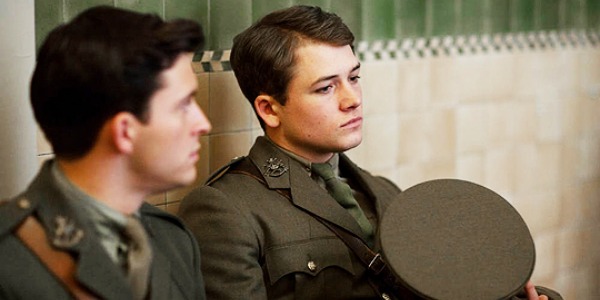
While costume is a major part of mise-en-scène make-up usually take a back seat. Of course it’s doing wonderful things, covering up tell tale signs on an actor’s face; bags that might belie the youth of the character, acne that may cause continuity problems, even scars that don’t fit in with the character’s back stories. It can also be used to refigure the actor’s face entirely so they fit the image of the original person (Charlize Theron in Monster) or take on another creature or species altogether (Zoe Saldana in Guardians Of The Galaxy).
Usually if the make-up is working you won’t notice it. However, it can play an important part when used overtly. An excellent example of the use of make-up is found in Mark Herman’s Brassed Off, where Phil’s depression and anger at his situation is in sharp contrast to his gaudy clown make-up.
For the most part, make-up works like setting. It has been used with a particular meaning in mind: the dramatic mascara, the pale face, the sexy red lipstick, all done to accentuate a particular aspect. They are factual parts of the character’s performance. Meaning is imbued when their make-up is juxtaposed with the scenario, usually one that follows the make-up’s original source scene. What was mascara is now, from crying, sweeping stains of dark marking the character’s face, reminding them and of us of the sadness that is still at play within them. The pale face is suddenly now suspect, it makes us wonder at the character’s internal world. Are they ill? Are they panicked?
The use of red lipstick is a piece of analysis all of its own. The application of red lipstick, and its smearing, has a rich history in cinema. It is linked to sexualisation and in all too many cases, foolishness and anger. Red lipstick is a weapon in cinema, and women are all too often unfairly punished for its use. In fact, the overt use of make-up in cinema has always in its way represented a problem in representing the female fairly on screen. Too often it is used as a short-cut to a dramatic mise-en-scène, a physical mark of a woman’s sadness or deceit, and one that demonises make-up and its use as frivolous and obscene.
This fascination with red lipstick can be found in Chaplin (where the young Mildred Pierce applies rouge), Who Framed Roger Rabbit? (when Jessica Rabbit attempts to seduce Eddie). It’s even a short-cut to comedy; the mark of a stolen kiss in Big Trouble In Little China, and often a sign of madness; Marietta in Wild At Heart. Red lipstick always means something on the cinema screen, and all the newly invented stay-put make-up won’t put an end to it.
Women’s hair, similarly to make-up, is used to accentuate their mood. However, the arrangement of their hair can also say a lot about the personality of the character. This can be done in men as well as women. The film Titanic is a great example, as comparisons can be drawn between the upper class and steerage. With the former’s tight, sharp or restrictive hairstyles a reflection of the world they live in. Conversely the hair of the latter is freer and they are in many ways more individual and unique looking. As Rose relaxes in her taste of freedom so her hair is let loose of its style. Cal’s short cropped hair is slicked back, only coming loose when his temper emerges. Drawing comparisons between hairstyle and character can be seen throughout all kinds of film, with slick back hair denoting control and coldness (mostly seen in evil bosses), while unkempt hair indicates individuality (these are often love interests).
Objects
The objects within a scene are usually not particularly circumspect, they are simply part of the action, unless the director is really trying to imbue the scene or the character with extra meaning. The objects you would immediately think of, as important in film are usually narrative tools. For example, the watch in Pulp Fiction is an instigator, a part of the story and action. The objects we talk about here are pieces that are placed into the shot or scene to remind the audience of particularly associations and encourage us to see extra depths in the scene’s meaning.
A fine example of this is found in the film Jack & Sarah where, on returning to his home, widower Jack slumps to the floor. A glass before him retains the lipstick marks of his now dead wife. This every day object now has a new, more powerful meaning. Jack’s shock at being confronted with it is not apparent in Richard E. Grant’s performance but in how the glass is revealed to us. We see the glass before we see his reaction and so it is the object that brings us into Jack’s pain.
The film Amélie is particularly rich with examples of objects and their meanings. This being a theme of the film itself is perhaps indicative of this. The Renoir painting that Mr Dufayel paints; a scene of close bodies and gestures and closeness that he cannot experience, the glass menu board that Amélie stands behind to get close to Nino, but still keep herself apart; representing her whole approach to intimacy, and the chicken with oysters that Dominique shares with his grandson in the film’s finale. They are all objects that seek to add meaning to the scenes they occupy, they externalise the character’s sadness or joy.
Jean-Pierre Jeunet has an endless fascination with objects and costume and colour. However, other directors choose to be more subtle. In Little Miss Sunshine the perfect, white bandages around Frank’s wrists remind us of his thwarted suicide attempt, and how he has neatly packaged away with his feelings. Jo covering up her wedding ring in the film Twister draws our attention to her feelings for Bill (her ex-husband). These objects and the associations we have with them are used to communicate the character’s internal world. They can also be transformed and given new meaning.
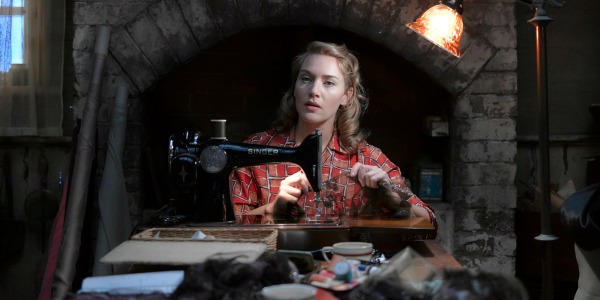
A great recent example of this can be found in The Dressmaker, where Tilly’s sewing machine is reimagined as a weapon. This film, as a whole, turns on its head the stereotypical Western, and in so doing turns Tilly’s sewing machine into the cowboy’s gun. It does this not only by celebrating Tilly’s influential glamour, but by training the camera on the sewing machine as she walks with it at her side, making it appear large in the shot, and accentuating its power. This new meaning means that whenever she is working at it, regardless of what she is wearing, she appears to us more powerful. Like a sharpshooter cleaning her gun.
This is the end of part one of “What is Mise-en-Scène?”. Find part 2 here, which focuses on cinematography, the actor, movement and editing.
Does content like this matter to you?
Become a Member and support film journalism. Unlock access to all of Film Inquiry`s great articles. Join a community of like-minded readers who are passionate about cinema - get access to our private members Network, give back to independent filmmakers, and more.
I love film, more than people probably, and I will watch pretty much anything. Seriously, anything! I have a postgraduate education in film & have spent an exceptionally long time trying to get inside the film industry. I'm a big believer in treating every film the same, and bringing something new to the film theory table, giving reasons for every argument made. You'll find that I'm an empathetic and fun sort of reviewer, at least, I like to think so. If I'm not watching films I'm doing exceptionally nerdy stuff, like watching documentaries about the history of medicine and collecting photos of old post boxes.













